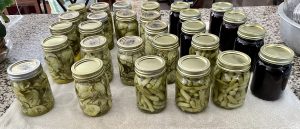Characters and Pressure
 My wife Cathy has spent this weekend canning and freezing: blackberry jam, bread and butter pickles, and corn. I’ve lent a hand: toting, shucking, mashing, cleaning. My mother spent her summers preserving food, so it’s a nostalgic thing for me to listen to the jar lids popping as they seal, the hot jars cooling, the air pressure in the jars changing, creating something of a vacuum that sucks the lids down. Hence, the pop.
My wife Cathy has spent this weekend canning and freezing: blackberry jam, bread and butter pickles, and corn. I’ve lent a hand: toting, shucking, mashing, cleaning. My mother spent her summers preserving food, so it’s a nostalgic thing for me to listen to the jar lids popping as they seal, the hot jars cooling, the air pressure in the jars changing, creating something of a vacuum that sucks the lids down. Hence, the pop.
Narratives also rely on pressure for their effect. A character’s action changes the pressure of the dramatic situation and probably the pressure within the character as well.
What do our characters want, or what do they fear? What are they desperate to protect? What do they pretend to know about themselves? What truths are they afraid to confront? These questions and their variations invite us to think about building pressure within our characters.
To help with that pressure, we might think about what external factors compel our characters, putting them into action. One character wants an expensive hunting rifle, maybe; in another story, a character might be afraid of driving in the dark. What is it about the rifle that appeals to the first character? What is it about driving in the dark that frightens the other? Now give the first character a reason not to buy that rifle. Maybe that character is saving money for college tuition. And what about the character in the other story? Maybe that character misses the bus and has no choice but to drive. We’re creating internal pressure from simultaneous desire and aversion.
Now let’s take it a step further. Let’s think about internal factors. Maybe the first character wants the rifle because they think it’ll help them with their self-esteem. Maybe the second character is afraid of driving in the dark because their father always belittled them for their lack of mechanical ability. Now think about an internal reason for not buying that rifle or for driving in the dark. Maybe the first character is fearful they won’t be a good shot. Maybe the second character wants to prove the father wrong.
The important thing is to establish contradictory impulses within our characters, so they’re pulled in different directions at the same time. When we can do that, we can increase not only the external pressure but the internal as well. The plot of the narrative, then, is shaped by this pressure trying to find its release. When that release comes in the climactic moment of the narrative, something either gets sealed in forever, or it’s let loose in a way that changes everything.
Extraordinary teaching. I so love your blogs. Every word hones skill. Today I am thinking. What are my external and internal reasons and realities for not writing more😇
Thank you so much, Rhonda! We all have our reasons for not writing. Sometimes listing them is a way of taking away their power and showing us how ineffectual they are. In a way, we eliminate them. The space and energy they were taking up then becomes ours to fill with our writing.